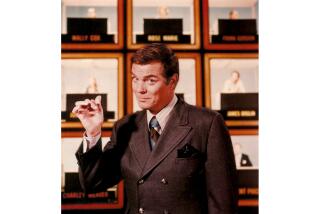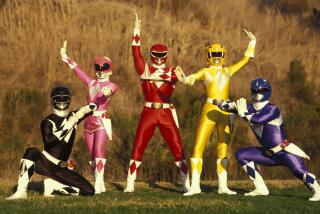‘Mister Rogers’ Viewed as Past Its Prime
- Share via
PITTSBURGH — Three decades after Fred Rogers took to the airwaves, it’s still a beautiful day in his neighborhood. Children’s television has moved on, though.
“The style of all other children’s shows are Technicolor sugared cereals, and the style of Mr. Rogers is a warm bowl of oatmeal,” said Robert Thompson, director of the Center for the Study of Popular Television at Syracuse University.
To many, the 71-year-old host of PBS’ “Mister Rogers’ Neighborhood” is a treasured icon who has endured despite the vast expansion of children’s programming on networks and cable channels.
Others see the show, which taped its final episode Dec. 1, as past its prime in the wake of faster-paced shows such as Nickelodeon’s “Blue’s Clues,” “Rugrats” and even another enduring PBS program, “Sesame Street.”
The final new show, taped in Pittsburgh, will air on PBS in August, and episodes will continue to air in repeats for years to come.
The show debuted at WQED, Pittsburgh’s public television station, in 1967. PBS started distributing it nationally in 1968, and there have been nearly 1,000 episodes in 33 seasons. While the show has featured specials on divorce and war, it never picked up the pace.
“It’s without a touch of irony in the age of ‘Rugrats’ and the ‘Powerpuff Girls,’ ” Thompson said. “Mr. Rogers has managed to never really let temporal styles of the time infiltrate what he does.”
Amy Jordan, a children’s television expert with the Annenberg Public Policy Center at the University of Pennsylvania, said “Rogers” appears dated compared to the plethora of children’s programming now available.
“For preschoolers, the world that he presents continues to be magical and wonderful and helpful in developing their imaginations,” she said. “But in terms of the overall TV landscape, in many ways he does reflect the period where he originated.”
Rogers came on the scene presenting material to preschoolers slowly, speaking directly to his young viewers and sometimes breaking into song.
Rogers’ influence is apparent even in current hits. Jordan said Nick Jr.’s “Blue’s Clues,” a favorite among the preschool set, was modeled after Rogers.
Cyma Zarghami, executive vice president and general manager of Nickelodeon, said that Nick Jr. series are consistent with Rogers’ show in that they focus on teaching preschoolers life skills more than how to read or write.
“But the difference is we try to be relevant to what’s going on in kids’ lives,” she said. “Mr. Rogers has been on the air for many years, and it is a charming show, but we change as kids change.”
Rogers declined to discuss his show or his future. But his spokeswoman, Hedda Sharapan, said a Rogers repeat is still relevant to children because they still need to feel good about themselves, develop self-control or appreciate others.
“Even though society has changed somewhat and children’s needs in the outside world have changed, their insides haven’t changed,” Sharapan said.
Thompson said another unique factor about Rogers is that “Mister Rogers’ Neighborhood” toys are absent from toy stores stocked with talking Big Birds, plush Blue’s Clues dogs and Powerpuff Girls dolls.
“We would rather say to children, if you want a trolley, use a tissue box to make your own kind of play,” Sharapan said. “You say to a child, ‘You can make anything out of something--it’s the richness of your imagination.’ ”
She said Rogers intends to focus on Internet ventures--at https://www.pbs.org/rogers and https://www.misterrogers.org--as well as write more children’s books and hold workshops for professionals involved in children’s issues.
More to Read
The complete guide to home viewing
Get Screen Gab for everything about the TV shows and streaming movies everyone’s talking about.
You may occasionally receive promotional content from the Los Angeles Times.






